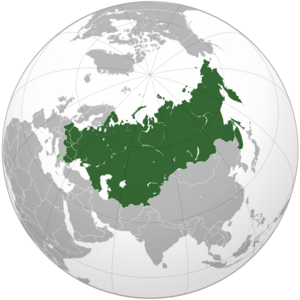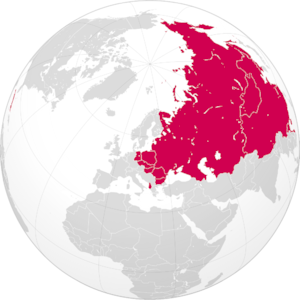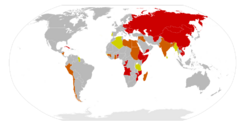Soviet empire facts for kids
The term Soviet empire refers to the many countries and areas around the world that the Soviet Union strongly controlled. This control was political, economic, and military. It was especially important during the Cold War. Some experts call this "Soviet imperialism" because the Soviet Union had a lot of power over these places, often called the Second World.
Even though these countries were supposed to be independent with their own governments, their choices had to fit within limits set by the Soviet government. If they didn't, the Soviet Union might threaten to change their leaders or even send in its army, sometimes with the help of the Warsaw Pact. Big military actions by the Soviets happened in East Germany in 1953, Hungary in 1956, Czechoslovakia in 1968, Poland from 1980 to 1983, and Afghanistan from 1979 to 1989. Countries in Eastern Europe that were part of this group were often called Soviet satellite states, not truly independent friends.

Contents
What Made It an Empire?
Even though the Soviet Union didn't have an emperor and said it was against empires, it acted like many empires from history. The idea of a "Soviet empire" means it was like a traditional empire, but with communism as its main belief instead of kings or queens.
One way the Soviets acted like an empire was through "internal colonialism" in places like Soviet Central Asia. For example, in Kyrgyzstan, the government focused on growing grain more than raising animals. This helped Slavic settlers more than the native Kyrgyz people, continuing unfair practices from the time of the Russian emperors. Some critics, like the Maoists, even said the Soviet Union had become an imperial power itself, even though it claimed to be socialist.
Another part of Soviet control was "cultural imperialism". This meant spreading Soviet culture and education and pushing aside local traditions. During the time of leader Leonid Brezhnev, there was a policy called Russification, which tried to make everyone more like Russians and give the central government more power.
A big wave of this "Sovietization" happened during the Russian Civil War and later in areas the Soviet army took over. After World War II, it spread to countries in Eastern and Central Europe like Czechoslovakia, East Germany, Hungary, Poland, and the Baltic states. This often meant setting up Soviet-style governments, holding elections where only approved candidates could run, taking over land and property, and punishing "class enemies" (like wealthy farmers). Many people were executed or sent to Gulag labor camps. This was all pushed by propaganda to create a common way of life across all Soviet-controlled states.
From the 1930s to the 1950s, leader Joseph Stalin ordered large groups of people, sometimes entire nationalities, to be moved to faraway, less populated areas. Their homes were often then given to ethnic Russians and Ukrainians. This policy officially ended when Nikita Khrushchev was leader, and some groups were allowed to return in 1957. However, groups like the Crimean Tatars and Russian Germans were not allowed to go back. In 1991, the Russian government called these mass deportations a "policy of defamation and genocide."
The Soviet Union lost about 20 million people during World War II. To prevent another such war, Soviet leaders believed they needed to create a system where neighboring countries depended on the USSR. This would create a "buffer zone" between them and Western Europe.
During the Brezhnev era, the Soviet Union said it was the most "developed socialist" country, meaning it was the best example of socialism. This idea, along with the Brezhnev Doctrine (which allowed the Soviet Union to invade other socialist countries), made many people see the USSR as an empire.
The Soviet Union also gave a lot of "international assistance" (money and resources) to countries that leaned socialist. This was more about gaining political influence than making money from them. In fact, this aid often hurt the Soviet Union's own economy. The goal was to have a group of countries that would support the Soviet Union if Western countries attacked, especially during the Cold War.
Formal or Informal Control?
Experts have different ideas about whether the Soviet empire was "formal" (like old empires with direct rule) or "informal" (where countries were technically independent but still controlled).
Some say it was a "formal empire" because it was very controlling, similar to how Lenin described the old Russian empire as a "prison of the peoples." They argue that under Stalin, it became even more like a "prison-house of nations."
Others see it as an "informal empire" over countries in the Warsaw Pact. These countries were officially independent, but the Soviet Union had a lot of pressure and military presence there. This informal control relied on money and support from Moscow. It also involved strong connections between the Communist Parties in these countries.
The informal empire also included Soviet investments, military presence, and secret actions in countries that supported the Soviet Union. For example, in the 1930s, the Soviet Union kept control over some areas in China, like the Chinese Eastern Railway, even though they had promised to give them up.
By the 1980s, the Soviet Union had both formal and informal control. When Mikhail Gorbachev gave up the Brezhnev Doctrine in 1989, the informal empire's pressure lessened. It became more like a regular "sphere of influence," similar to how Finland managed its relationship with the Soviet Union, until the Soviet Union finally broke apart in 1991.
Countries Allied with the Soviet Union
Warsaw Pact Members
These countries were the closest allies of the Soviet Union and were also part of Comecon, an economic group led by the Soviets. The members of the Warsaw Pact were often called Eastern Bloc countries or Soviet satellite states. The Soviet army had occupied or previously occupied them, and the Soviet Union controlled their politics, military, and foreign and domestic policies.
The Warsaw Pact included:
 Albania (1946–1968)
Albania (1946–1968) Bulgaria (1946–1990)
Bulgaria (1946–1990) Czechoslovakia (1948–1990)
Czechoslovakia (1948–1990) East Germany (1949–1990)
East Germany (1949–1990) Hungary (1949–1989)
Hungary (1949–1989) Poland (1947–1989)
Poland (1947–1989) Romania (1947–1960s)
Romania (1947–1960s)
The Soviet Union also had two of its own republics with seats in the United Nations General Assembly:
 Byelorussian Soviet Socialist Republic (Belarus)
Byelorussian Soviet Socialist Republic (Belarus) Ukrainian Soviet Socialist Republic (Ukraine)
Ukrainian Soviet Socialist Republic (Ukraine)
Other Communist States
These countries were communist and allied with the Soviet Union but were not part of the Warsaw Pact.
 Afghanistan (1978–1991)
Afghanistan (1978–1991) Angola (1975–1991)
Angola (1975–1991) Benin (1975–1990)
Benin (1975–1990) People's Republic of China (1949–1961)
People's Republic of China (1949–1961) Congo (1969–1991)
Congo (1969–1991) Cuba (1959–1991)
Cuba (1959–1991) Ethiopia (1974–1991)
Ethiopia (1974–1991) Kampuchea (1979–1989)
Kampuchea (1979–1989) Grenada (1979–1983)
Grenada (1979–1983) North Korea (1948–1991)
North Korea (1948–1991) Lao People's Democratic Republic Laos (1975–1991)
Lao People's Democratic Republic Laos (1975–1991) Mongolia (1924–1991)
Mongolia (1924–1991) Mozambique (1975–1990)
Mozambique (1975–1990) Somalia (1969–1977)
Somalia (1969–1977) Tuva (1921–1944)
Tuva (1921–1944) North Vietnam (1954–1976), then Vietnam (1976–1991)
North Vietnam (1954–1976), then Vietnam (1976–1991) South Yemen (1967–1990)
South Yemen (1967–1990) Yugoslavia (1945–1948)
Yugoslavia (1945–1948)
Non-Communist Countries Allied with the Soviet Union
Some countries in the Third World had governments that supported the Soviet Union during the Cold War. The Soviet Union called these "countries moving along the socialist road of development." They received some military or economic help from the Soviet Union and were influenced by it. Sometimes, their support for the Soviet Union ended for different reasons.
These included:
 Algeria (1962–1991)
Algeria (1962–1991) Bangladesh (1971–1975)
Bangladesh (1971–1975) Burkina Faso (1983–1987)
Burkina Faso (1983–1987) Burma (1962–1988)
Burma (1962–1988) Cape Verde (1975–1990)
Cape Verde (1975–1990) Chile (1970–1973)
Chile (1970–1973) Egypt (1954–1978)
Egypt (1954–1978) Ghana (1964–1966)
Ghana (1964–1966) Guinea (1960–1984)
Guinea (1960–1984) Guinea Bissau (1973–1991)
Guinea Bissau (1973–1991) Equatorial Guinea (1968–1979)
Equatorial Guinea (1968–1979) India (1971–1991)
India (1971–1991) Indonesia (1959–1965)
Indonesia (1959–1965) Iraq Iraq (1958–1963; 1968–1990)
Iraq Iraq (1958–1963; 1968–1990) Jamaica (1972–1980)
Jamaica (1972–1980) Libya (1969–1991)
Libya (1969–1991) Madagascar (1975–1991)
Madagascar (1975–1991) Mali (1960–1991)
Mali (1960–1991) Nicaragua (1979–1990)
Nicaragua (1979–1990) Palestine (1988–1991)
Palestine (1988–1991) Peru (1968–1975)
Peru (1968–1975) Sahrawi Arab Democratic Republic (1976–1991)
Sahrawi Arab Democratic Republic (1976–1991) Sao Tome and Principe (1975–1991)
Sao Tome and Principe (1975–1991) Seychelles (1977–1991)
Seychelles (1977–1991) Sudan (1969–1985)
Sudan (1969–1985) Syria (1955–1991)
Syria (1955–1991) Tanzania (1964–1985)
Tanzania (1964–1985) Turkey (1923–1930)
Turkey (1923–1930) Uganda (1969–1971)
Uganda (1969–1971) North Yemen (1962–1972)
North Yemen (1962–1972) Zambia (1964–1991)
Zambia (1964–1991) Zimbabwe (1980-1991)
Zimbabwe (1980-1991)
Communist Countries Opposed to the Soviet Union
Some communist countries did not agree with the Soviet Union and criticized its policies. Even though they might have been similar to the USSR in how they ran their own countries, they were not considered Soviet allies in international politics. Their relationship with the Soviet Union was often tense, sometimes even leading to armed conflict.
These included:
 Albania (1960–1983)
Albania (1960–1983) Cambodia (1975–1979)
Cambodia (1975–1979) China China (1961–1983)
China China (1961–1983) Romania (1960s-1983)
Romania (1960s-1983) Somalia (1977–1991)
Somalia (1977–1991) Yugoslavia Yugoslavia (1948–1955)
Yugoslavia Yugoslavia (1948–1955)
Neutral Countries
Finland's Unique Position
The situation with Finland was complicated. The Soviet Union invaded Finland in 1939, starting the Winter War. The Soviets wanted to set up their own government in Finland and make it part of the Soviet Union. But Finland fought back fiercely, and the Soviets couldn't achieve their goal. A peace treaty was signed in 1940.
Finland later joined Germany in invading the Soviet Union in 1941. Finland took back land it had lost and occupied more territory. The Soviets pushed Finland back in 1944, but Finland stopped their attack. The war ended, and Finland kept most of its land and its market economy. It traded with Western countries and joined Western financial systems.
However, even though Finland was neutral, a treaty with the Soviet Union in 1948 greatly limited Finland's foreign policy choices. Finland had to promise to defend the Soviet Union if it was attacked through Finnish land. This meant Finland couldn't join NATO and effectively gave the Soviet Union a say in Finland's foreign policy. This shows how the Soviet Union could still have "imperial" power even over a neutral country. Finland tried to keep good relations with the Soviet Union, and they had a lot of trade. In the West, this led to worries about "Finlandization"—the idea that Western allies might stop fully supporting the United States and NATO.
See Also
- Cold War
- Imperialism
- Russian imperialism
- Sovietization




